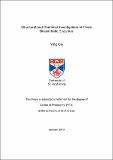Structural and chemical investigation of three biosynthetic enzymes
Abstract
Ribosomally synthesized and post-translationally modified peptides (RiPPs) are a
burgeoning family of natural products with desirable bioactivities. The cyanobactin
class of RiPPs have demonstrated anticancer, anti-microbial activities and more, and
have therefore attracted research attentions. Cyanobactins are synthesised as a precursor
peptide (PatE homologues) containing recognition sequences and core peptides (sequences
that become the final products), the latter of which undergo various modifications
including heterocyclization, prenylation, oxidation and macrocyclization. The posttranslational
modification enzymes (PTMEs) utilised to modify the cyanobactin precursor
have demonstrated magnificent versatilities that are potentially exploitable for the creation
of libraries of natural and unnatural compounds. The structure and function of each
of these enzymes are reviewed in Chapter 1, along with the current application of the
cyanobactin biosynthetic pathway.
Chapter 2 describes my work on creating and characterising modified heterocyclases.
The leader peptide was appended to heterocyclases that produce both thiazolines and
(methyl)oxazolines. The modified catalysts are not only capable of utilising leaderless
peptides, but also have higher yields than the native enzyme.
The next chapter investigates the reaction order of heterocyclase enzymes. The leader
peptide was found to be partially responsible for the reaction order. In Chapter 4 the same
investigation was applied to the oxidase, which aromatises and stabilises the heterocycles.
The oxidase reaction was determined to be independent of the leader.
Chapter 5 delves into the phosphate chemistry of the heterocyclase, which uses
ATP/Mg²⁺ via a kinase mechanism, but subsequently catalyses additional reactions that
yield AMP and PPᵢ.
Finally, Chapter 6 describes the structural characterisation of Psychrobacter arcticus
ATP phosphoribosyltransferase (ATPPRT), which is the first dedicated enzyme in
histidine biosynthesis, and provides a key regulatory point for this pathway.
Type
Thesis, PhD Doctor of Philosophy
Collections
Description of related resources
Melo Czekster , C , Ge , Y & Naismith , J H 2016 , ' Mechanisms of cyanobactin biosynthesis ' , Current Opinion in Chemical Biology , vol. 35 , pp. 80-88 . https://doi.org/10.1016/j.cbpa.2016.08.029 (http://hdl.handle.net/10023/11669)Stroek , R , Ge , Y , Talbot , P D , Glok , M K , Bernas , K E , Thomson , C M , Gould , E R , Alphey , M S , Liu , H , Florence , G J , Naismith , J H & da Silva , R G 2017 , ' Kinetics and structure of a cold-adapted hetero-octameric ATP phosphoribosyltransferase ' , Biochemistry , vol. 56 , no. 5 , pp. 793-803 . https://doi.org/10.1021/acs.biochem.6b01138 (http://hdl.handle.net/10023/12496)
Alphey , M S , Fisher , G , Ge , Y , Gould , E R , Guerreiro Machado , T F , Liu , H , Florence , G J , Naismith , J H & da Silva , R G 2018 , ' Catalytic and anticatalytic snapshots of a short-form ATP phosphoribosyltransferase ' , ACS Catalysis , vol. 8 , no. 6 , pp. 5601-5610 . https://doi.org/10.1021/acscatal.8b00867 (http://hdl.handle.net/10023/17684)
Gao , S , Ge , Y , Bent , A F , Schwarz-Linek , U & Naismith , J H 2018 , ' Oxidation of the cyanobactin precursor peptide is independent of the leader peptide and operates in a defined order ' , Biochemistry , vol. 57 , no. 41 , pp. 5996-6002 . https://doi.org/10.1021/acs.biochem.8b00835 ( http://hdl.handle.net/10023/18467)
Items in the St Andrews Research Repository are protected by copyright, with all rights reserved, unless otherwise indicated.

